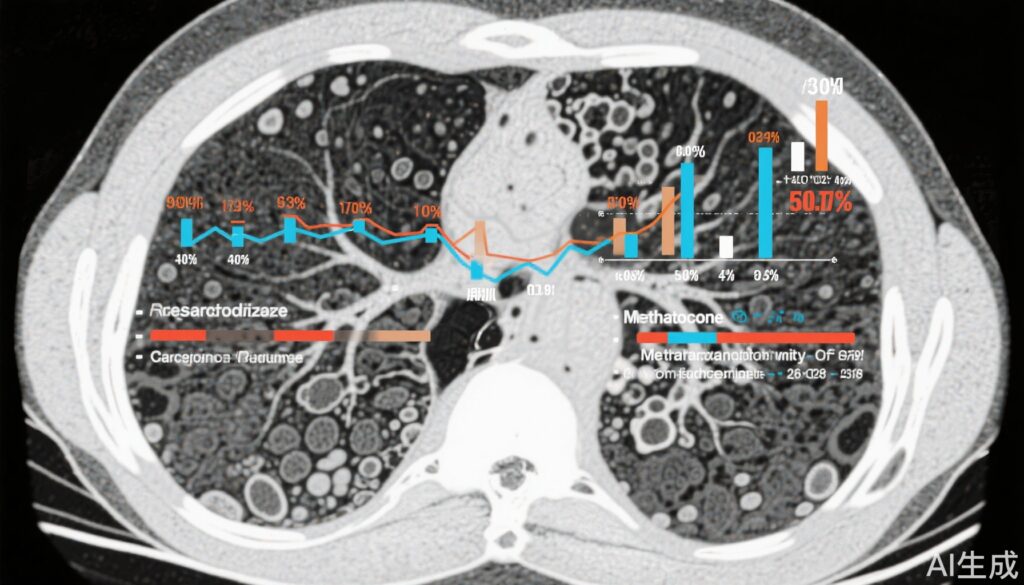Highlight
- Methotrexate is noninferior to prednisone in improving forced vital capacity (FVC) after 24 weeks in treatment-naïve pulmonary sarcoidosis patients.
- Prednisone and methotrexate show distinct side-effect profiles, with prednisone causing weight gain and insomnia, and methotrexate associated with nausea and liver-function abnormalities.
- Shared decision-making considering efficacy and adverse effect profiles can optimize individualized treatment strategies in pulmonary sarcoidosis.
Clinical Background and Disease Burden
Pulmonary sarcoidosis is a multisystem granulomatous disorder predominantly affecting the lungs. It manifests with varying degrees of pulmonary inflammation and fibrosis, which can lead to impaired lung function and reduced quality of life. Prednisone, a corticosteroid, remains the standard first-line therapy due to its rapid anti-inflammatory effects. However, its use is frequently limited by a spectrum of adverse effects including weight gain, insomnia, and metabolic complications. Methotrexate, an immunosuppressant traditionally used as a second-line agent, has demonstrated efficacy with a reportedly more favorable side-effect profile but slower onset. Given the chronic nature of sarcoidosis and the need to balance treatment efficacy against toxicity, robust comparative data are essential to optimize initial therapeutic decisions.
Research Methodology
The PREDMETH study was a multicenter, open-label, randomized, noninferiority trial enrolling 138 treatment-naïve patients with pulmonary sarcoidosis. Participants were assigned in a 1:1 ratio to receive either prednisone or methotrexate according to a standardized treatment protocol. The primary endpoint was the mean change from baseline to 24 weeks in the percentage of predicted forced vital capacity (FVC), a key measure of pulmonary function. Mixed models for repeated measures were utilized for evaluation, with a noninferiority margin set at 5 percentage points for FVC change. Secondary analyses included the assessment of adverse events and tolerability profiles.
Key Findings
Of the 138 randomized patients, 70 received prednisone and 68 methotrexate. At 24 weeks, the unadjusted mean improvement in predicted FVC was 6.75 percentage points (95% CI, 4.50 to 8.99) in the prednisone group and 6.11 percentage points (95% CI, 3.72 to 8.50) in the methotrexate group. The adjusted between-group difference was −1.17 percentage points (95% CI, −4.27 to 1.93), demonstrating methotrexate’s noninferiority to prednisone within the pre-specified margin. The incidence of adverse events was similar between groups; however, the nature of side effects varied. Prednisone was more commonly associated with weight gain, insomnia, and increased appetite, whereas methotrexate led to nausea, fatigue, and abnormal liver function tests. These data suggest comparable efficacy but divergent toxicity profiles.
Expert Commentary
This timely study challenges the entrenched paradigm of prednisone as the unequivocal first-line agent by providing high-quality evidence supporting methotrexate’s role as an effective initial therapy. Given the chronicity and potential treatment-related morbidity in pulmonary sarcoidosis, having an alternative with a distinct side effect spectrum expands therapeutic options. Clinicians should weigh patient-specific factors including comorbidities, risk of corticosteroid-induced complications, and patient preferences. The study’s open-label design and 24-week follow-up provide relevant real-world insights, although longer-term outcomes remain to be elucidated.
Controversies and Limitations
While the trial robustly demonstrates methotrexate’s noninferiority, the open-label methodology may introduce bias in subjective adverse event reporting. The relatively short duration of 24 weeks limits assessment of long-term efficacy and safety, especially concerning methotrexate’s delayed onset and cumulative toxicity. Furthermore, the study population was limited to patients without prior treatment, and findings may not extrapolate to more advanced or refractory cases. Future studies should address these gaps and evaluate quality-of-life outcomes.
Conclusion
The PREDMETH trial provides compelling evidence that methotrexate is a viable first-line treatment option for pulmonary sarcoidosis, offering comparable improvements in lung function to prednisone at 24 weeks. Distinct side-effect profiles necessitate individualized treatment decisions, emphasizing shared decision-making. Incorporating methotrexate earlier in the treatment algorithm may reduce corticosteroid exposure and its associated morbidity. Ongoing research is needed to define long-term outcomes and optimal patient selection.
References
1. Kahlmann V, Janssen Bonás M, Moor CC, et al. First-Line Treatment of Pulmonary Sarcoidosis with Prednisone or Methotrexate. N Engl J Med. 2025;393(3):231-242. doi:10.1056/NEJMoa2501443
2. Kahlmann V, Janssen Bonás M, Moor CC, et al. Design of a randomized controlled trial to evaluate effectiveness of methotrexate versus prednisone as first-line treatment for pulmonary sarcoidosis: the PREDMETH study. BMC Pulm Med. 2020;20(1):271. doi:10.1186/s12890-020-01290-9


